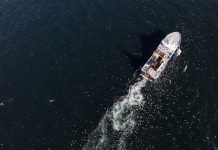A highly sensitive sensor that combines a variety of testing means (electrochemistry, spectroscopy and selective partitioning) into one device has been developed at the University of Cincinnati. It’s already been tested in a variety of settings – including testing for components in nuclear waste.
The sensor is unusual in that most sensors only have one or two modes of selectivity, while this sensor has three. In practical terms, that means the UC sensor has three different ways to find and identify a compound of interest.
That’s important because settings like a nuclear waste storage tank are a jumbled mix of chemical and radioactive wastes. The sensor, however, would have a variety of applications, including testing in other environments and even medical applications.
Research related to this novel sensor will be presented at the American Chemical Society biannual meeting March 27-31 in Anaheim, California, in a presentation titled “Using Spectroelectrochemistry to Improve Sensor Selectivity.”
That presentation will be made March 28 by William Heineman, distinguished research professor of chemistry at the University of Cincinnati. Heineman has published more than 400 research articles on spectroelectrochemistry, electroanalytical chemistry, bioanalytical chemistry and chemical sensors, and has won numerous national and international awards for his work.
The sensor has, in fact, been tested at the Hanford site, a mostly decommissioned nuclear production complex in Washington state, where it was used to detect one important component of the radioactive and hazardous wastes stored inside the giant tanks there.
The basic design and concept for this monitor could be used in many other environmental or medical settings. These include detection of toxic heavy metals and polycyclic aromatic hydrocarbons at superfund sites.
In projecting the future potential for this technology emphasis falls on the current crisis at the Fukushima nuclear power station. As Japanese engineers calculate it will be up to two weeks before they can declare the site safe from radiation fallout.
The restoration of power to the stricken plant, 140 miles north of Tokyo, had led to hopes that the threat of a meltdown and major radiation leak was past. But scientists say they are not out of the woods yet and they still face some of the most difficult and dangerous tasks.
They include manually draining hundreds of gallons of radioactive water from the plant and “bleeding” radioactive gas from the pumps and piping of the emergency cooling systems.
Technicians are also increasingly concerned about salt build-up inside the reactors caused by evaporated seawater. Crusts forming around fuel rods could block cooling water from getting to the radioactive fuel and cause them to start heating up again.
Having access to technology that detects hazardous compounds with greater accuracy would help engineers secure toxic sites like Fukushima and prevent further contamination faster than currently possible.
Source: University of Cincinnati / Daily Telegraph UK

















